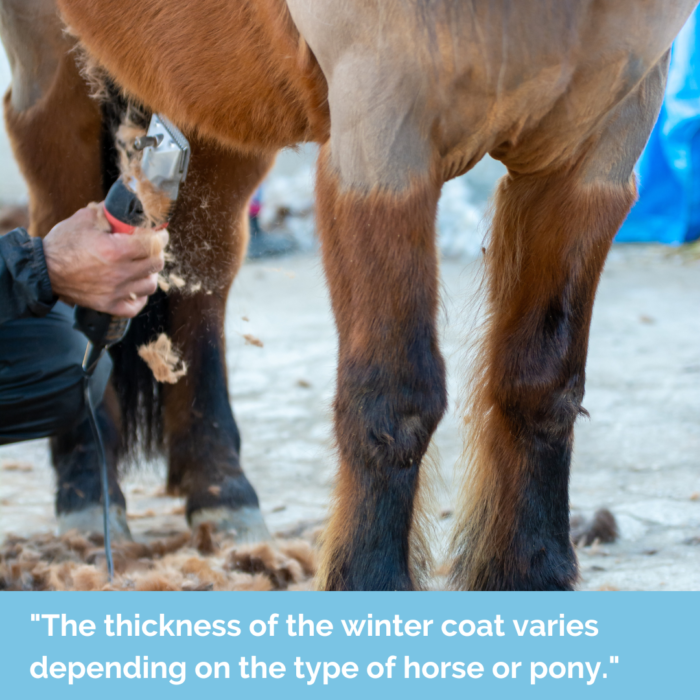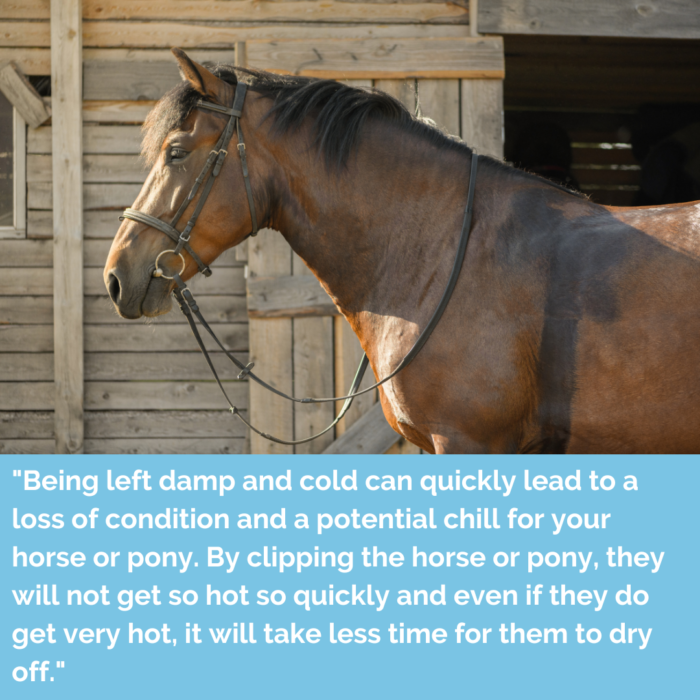The clocks have gone back, the nights are swiftly drawing in and Christmas isn’t too far away. For those of us that own horses this raises a number of seasonal issues, one of which, is the question of when should you clip your horse? Our horse insurance team here at SEIB investigates when is best.
In the late summer and early autumn, horses and ponies begin to grow out their sleek summer coats and a coarser, thicker winter coat grows through to keep them warm over the cold winter months. The thickness of the winter coat varies depending on the type of horse or pony. Native and traditional types will grow a very thick, shaggy coat designed to keep them nice and warm in the most inhospitable hillside conditions. Finer coated thoroughbreds and warmbloods will still grow a thicker, denser coat that can sometimes appear almost fluffy in texture throughout the winter months.

Not all horses will need to be clipped. Often very young or very old horses and ponies are unlikely to need clipping and many horses not in work may not be in need of clipping either. The main reasons for clipping often centre around keeping a horse or pony healthy and happy and able to do their job through the winter months. There are also many varied medical reasons people choose to clip their horses or ponies such as those suffering from illnesses including cushings and mud fever.
When horses and ponies are exercised, they sweat, and a thick winter coat can take a long time to dry out after exercise, particularly on a wet day. Being left damp and cold can quickly lead to a loss of condition and a potential chill for your horse or pony. By clipping the horse or pony, they will not get so hot so quickly and even if they do get very hot, it will take less time for them to dry off. A clipped horse or pony will need to wear a rug.

Many people believe in clipping their horse once the clocks have changed and the days are shorter as they can juggle the riding and drying their horse out up until this point. Often, it can be a good idea to clip the horse as few times throughout the winter as possible owing to factors such as the expense of paying someone to clip your horse for you, or if your horse doesn’t enjoy the experience and finds it a stressful procedure.
If you clip your horse for the first time of the season at the end of September or in October, there is every chance that his coat will have grown back and you will need to clip him again in November. By holding off until November for the first clip, you may only have to complete the procedure twice throughout the winter – an early November clip and a Christmas time clip. Traditionally, people wouldn’t clip their horses much after Christmas as the worry was that the summer coat may start growing through and would become damaged by the clippers.
In more modern times, clipping often takes place throughout the winter months and occasionally into Spring. There are plenty of people that offer a professional clipping service for your horse. If you use someone that is experienced in clipping horses to clip your horse, they are likely to get the procedure undertaken quickly and calmly and the clip will be neat and even. Always make sure that the person you use to clip your horse or pony has the correct insurance in place for the job.
About SEIB
SEIB have been arranging insurance for horses for over 50 years. This experience allows us to tailor policies to suit your circumstances and ensure that you and your horses are covered should the worst happen.